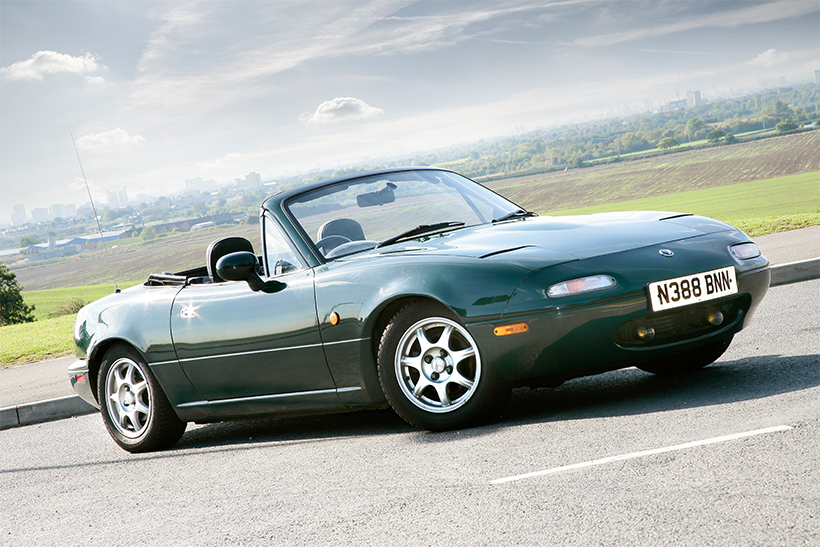Here are 10 interesting facts about the Mazda MX-5 Mk1 you may not know…
Pin sharp handling and a near ideal weight balance makes the MX–5 a great drivers’ car. Early ones cost peanuts and a fully loaded import from the Land of the Rising sun makes a lot of sense.
The worlds most successful sports car will be thirty years old next year – a gamble by the small Japanese car company that turned out to be a knockout hit with sales that exceeded all expectations. The MX-5 was the perfect sports car – great looking with strong Lotus Elan overtones, a 1.6 litre twin-cam engine, five speed gearbox and handling that, if the car were to be launched today, would still be considered excellent. All that wrapped up in the usual reliable Japanese package that was properly made meant the MX-5 was just what the market ordered.
Despite so many being built, the original ‘NA’ MX-5 is currently an endangered species. Mazda were never very hot on rust protection back then and whilst it was a well made car and good enough to last ten years in Japan, European (particularly British) winters could make a mess of them.
This translates into there not being many NA cars that can claim to be original and un-welded. MX-5’s are now quite rare in Japan (where they were badged differently) but it’s about the only place to find a rust free original example – but just remember to get it pumped full of anti-rust wax if you find one!
1 The original MkI MX-5 sold over 400,000 units between its 1989 launch and the end of production in 1997. In comparison, BMC/BL sold around 500,000 MGB’s in eighteen years, meaning that the MX-5 outsold the British car by two to one. The 1997 BMW Z3 often came quite close year on year, but never managed to equal the Mazda’s overall sales figures – and it was nowhere near as good to drive.
2 The MX-5 came about as the result of a conversation in 1976 between Bob Hall from Motor Trend magazine and the two top executives of Mazda. Hall was fluent in Japanese and impressed the Mazda execs to the extent that he moved to Japan in 1981 to take up a position in product planning. In 1982 the MX-5 idea was revived and serious planning took place.
3 The MX-5 was styled in California, once the heartland of British sports car sales. Mazda had formed a new design studio there in 1980 and there was to be a competition to find the right design. Mark Jordan’s Californian team proposed a front engine rear drive layout and the Tokyo based Mazda team came up with a front drive design – the American design won hands down.
4 Getting final approval in 1986 resulted with the concept passing to the production phase immediately and the MX-5 was launched in February 1989, with the first cars delivered that May. Reaction was very favourable and demand far outstripping supply with many dealers, raising the original $14,000 sticker price. The Japanese market was next in September 1989 and Europe got the new car in early 1990.
5 The MX5 was known by various names around the world. In Japan it was not badged as a Mazda at all but was known as the Eunos Roadster, an early example of Japanese sub-branding. In the US the car was called the Mazda MX5 Miata and only in Europe was the single MX-5 name used – it’s a good way of distinguishing imports and telling where an MX-5 has come from.
6 The MX-5 was not designed to a strict budget. For example, the engine was a 1.6 litre (1598cc) Mazda unit but it had been redesigned to rev to over 7000rpm safely. To this end, the steel crank and flywheel were both lightened and various other mods made to allow it to rev to 7200 with a power output of 120bhp. The sump was now finned alloy to aid oil cooling as well.
7 The MX-5’s gearbox was a rear drive Mazda 626 unit, but a team was set up with one aim, and that was to perfect the gear change. Mazda were crossing the T’s and dotting the i’s with this one and the result was a light, short shift gear change that could be flicked up the ratios with lightning speed. An automatic gearbox was offered in the US but it was not popular – what a surprise!
8 In 1994, the MX-5 was upgraded with a bigger 1800cc engine developing 128bhp and offering a useful boost in mid range torque. A limited slip differential had been an option on the original 1600 cars, and this continued with the 1.8 although it remains quite a rare thing to find now. The limited slip diff is in fact a Torsen type and not the old type clutch plate type, so they don’t wear out.
9 The MX-5 was more advanced than it might have looked initially. As well as having all-round disc brakes, the MX-5 also featured what Mazda called a ‘powerplant frame’ (PPF) and the front and rear suspension is fitted to detachable subframes. The weight distribution was 50/50 and the total car weight just 970 kilos. 0-60 was achieved in 8.3 seconds and the top speed 126mph.
10 The MX-5 proved to be very popular in the US for track driving even when new whilst in the UK, Brodie Brittain Racing (BBR) produced a 150bhp turbo conversion. Despite having only a modest power boost to maintain reliability, the conversion was good enough to retain the standard Mazda warranty and the performance was as good as the front drive M100 Lotus Elan.






